London is renowned for dividing the opinions of the British population, with some insisting that the ‘Big Smoke’ is the best place on earth, and others branding it as too busy and expensive.
Whichever side of the fence you are on, it is clear that every borough in the huge city comes with its own pros and cons — from green spaces and amenities to noise complaints and travel options.
With all of this in mind, the team here at Essential Living has crunched the numbers to determine the best and the worst London boroughs to live in.
This was achieved by analysing eight important factors:
- The number of publicly accessible parks
- Percentage of accessible tube stations
- Percentage of cheaper supermarkets
- Distance to the centre
- Cost of travel to the centre by public transport and bus only
- Average house prices
- Percentage of noise complaints per borough population
London is made up of 32 boroughs as well as the City of London. Inner London is made up of 12 boroughs while the remaining 20 make up outer London. Our study looked at all 32 boroughs, taking into account size as well.
Once the data was collated and each location had received an overall score out of 80, the London Borough Index was revealed.
Which are the best and worst London boroughs to live in overall?
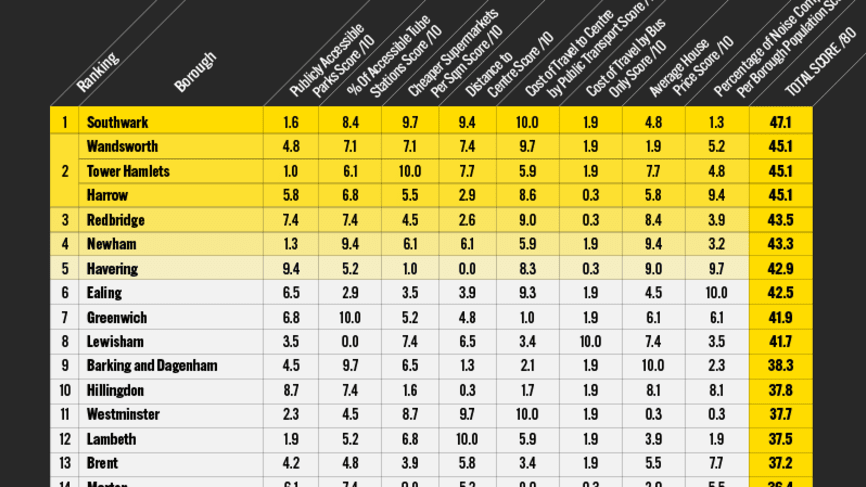
Our data revealed that Southwark is the best London borough to live in, with an overall score of 47.1 out of 80. Those needing to commute to the city centre are in luck, as the area's distance to the city centre scored 9.4 /10, and public transport scored 10.0/10, meaning travel is affordable. There are also 14 budget-friendly supermarkets in Southwark - scoring 9.7/10 - making it all the more easy to grab some bargains in the weekly shop.
Wandsworth bags the spot as the second-best London borough with a reputable score of 45.1/80. The area scored 9.7/10 for its cost of public transport to the centre and 7.4/10 for its distance to the centre, making travel easily reachable and affordable to everyone. Wandsworth is also very accommodating to those travelling with a disability, scoring 7.1/10 for its percentage of accessible tube stations.
Tower Hamlets joins Wandsworth as the second best borough in London to live in, with a respectable score of 45.1/80. With the average house price score at 7.7/10, Tower Hamlets is an affordable location in London to make a house a home. The distance to the city centre scored 7.7/10, making commuting or popping to the shops easy. Those living in the area will also benefit from a variety of cheaper supermarkets, scoring 10.0/10 for the number of budget-friendly stores per sqm.
Harrow was the final borough to join Tower Hamlets and Wandsworth in joint second place with an overall score of 45.1/80. Those looking for a tranquil night’s sleep are pretty much-guaranteed peace and quiet in the area with a noise complaints score of 9.4/10. The location is also great for affordable travel, scoring 8.6/10, meaning your morning commute won’t break the bank.
Kingston upon Thames takes the title of the worst borough to live in overall in London, with an unfortunate score of 22.9/80. The location scored 0.0/10 for its accessible tube stations, making it extremely difficult for disabled travellers. The area also received disappointing scores for its unaffordable public transport with a 0.7/10, and house prices in the area coming in with a price tag that’s just too hefty; giving the borough a score of 2.3/10.
Which of the London boroughs has the greenest space?

Next up, we analysed which of the London boroughs had the most accessible green spaces to explore, measuring in hectares (10,000 square metres).
In first place, with a maximum score of 10.0/10 was Bromley, boasting a staggering 2,585 hectares of green space. This would make the borough an ideal location for bringing up children or living with pets as there are numerous spots for walks and outdoor activities.
Richmond-Upon-Thames was next on the list, with an impressive score of 9.7/10. This was down to having 2,371 hectares of accessible green spaces, putting the borough very close to Bromley in this category.
Havering was in third place with an overall ranking of 9.4/10, due to 2,078 hectares of wide open spaces to enjoy. All of the top three locations had a very similar amount of greenery, revealing that London is surprisingly abundant when it comes to green belt land.
However, trailing in last place was Islington, with a measly score of 0.0/10. This is down to only offering up 155 hectares of accessible green spaces. All of these scores were calculated by analysing the Natural Capital Accounts for Public Green Space in London, allowing us to reveal how suitable each of the boroughs would be for families and people that enjoy walking and being outside.
Which London borough has the highest percentage of accessible tube stations?
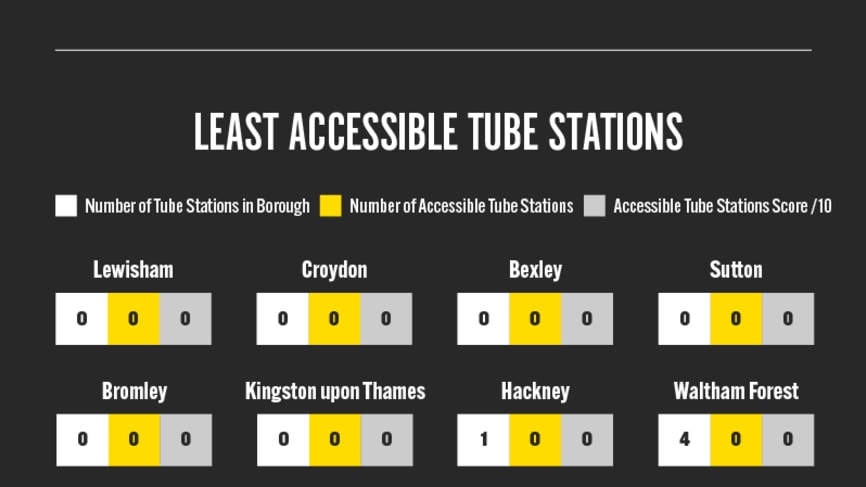
Accessibility is essential on public transport - from ramps for wheelchairs to having enough space to fit them in once on board. Anybody who has visited a tube station will know that they come with a lot of stairs, as well as a lot of walking around. Due to this, it is important that people with disabilities are aware of which tube stations offer step-free access to and from the street and the platform. That’s why we calculated what percentage of the total amount of tube stations in each borough were accessible.
It was revealed that Greenwich secured the title as the London borough with the highest percentage of accessible tube stations. Although the borough only has one tube station, this is reflective of its area size of 18.28 square metres. So one tube station is accessible, meaning they scored an impressive 10.0/10.
Barking and Dagenham landed a spot in second place with three out of the five tube stations in the area being accessible, giving the location an accessible tube stations score of 9.7/10 and an accessibility percentage of 60.00%.
Finishing up the top three is Newham, with four out of the seven tube stations being easily accessible for disabled travellers. This gave the borough a score of 9.4/10 and a percentage of 57.14% for its accessible tube stations.
However, despite so many areas making it very easy for disabled people to get back to the hustle and bustle of the big city, many boroughs don’t have any accessible tube stations around them at all. A whopping eight locations scored 0.0/10, including the likes of Lewisham, Hackney, Bexley, Sutton, Waltham Forest, Croydon, Bromley and Kingston upon Thames - highlighting a need for more accessible tube stations in these areas.
Which London borough has the highest percentage of budget-friendly supermarkets in the area?
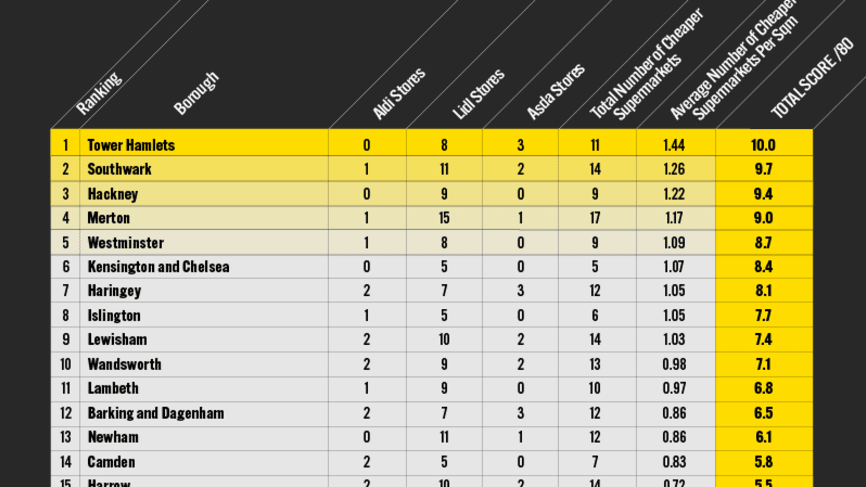
Another extremely important aspect to consider when moving locations is the surrounding amenities - nobody wants to have to drive miles to buy essential groceries. With the rising costs due to inflation, we analysed the boroughs with the highest average number of Aldis, Lidls and ASDAs, which are the three cheapest UK supermarkets, per square metre of each borough. Then, this was determined by an overall score out of 10.
In first place was the borough of Tower Hamlets with a winning score of 10.0/10, as a result of having eight Lidl stores and three ASDA stores for shoppers to choose from. With 11 cheaper supermarkets in total, that means there are 1.44 cheaper supermarkets per square metre in this borough.
Southwark is crowned the second-best London borough to do a weekly shop on a budget with a score of 9.7/10. The area has one Aldi store, eight Lidl stores and two ASDA supermarkets, meaning there are 1.26 bargain supermarkets for every square metre in this borough.
Shoppers looking to save on their food shop should pay Hackney a visit, as it emerges in third place with a score of 9.4/10. Unfortunately, there are no ASDAs or Aldi stores in this borough, so shoppers’ will need to be a fan of Lidl with a whopping nine stores! Overall, this equates to 1.22 cheaper supermarkets per square metre in Hackney.
Bromley is revealed as the worst location to do an affordable food shop with a disappointing score of 0.0/10. With a total area size of 57.97 square metres, Bromley only has two cheaper supermarkets, equating to 0.03 cheaper supermarkets per square metre.
Which London borough has the most cost-effective and convenient travel options?
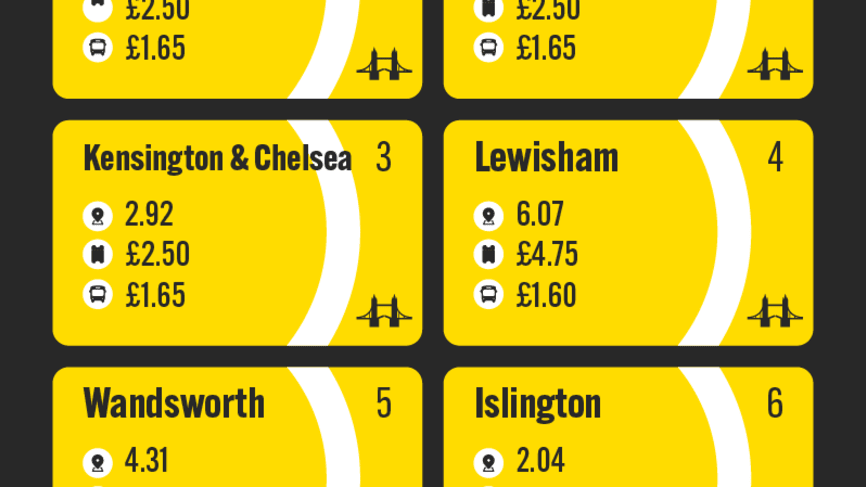
Next up, we crunched the numbers around the boroughs with the most convenient travel options. This took into account:
- The distance to the city centre in miles
- The cost to travel by public transport
- The cost of travelling by bus only.
This allowed us to give each borough a score out of 30 overall.
Westminster placed first, with an overall ranking of 21.6/30. This was achieved thanks to the borough only being a reasonable 1.1 miles out of the city centre, allowing it to score 9.7/10 in the distance category. It also received a maximum score of 10.0/10 when it came to the cost of travel to the city centre, with £2.50 being the average cost.
Up in second place was Southwark, scoring 21.3/30 overall. This borough also had an average cost of £2.50 to get to the city centre, as well as an impressive score of 9.4/10 when it came to the distance to the city centre (1.73 miles).
Despite scoring so high in other areas, both boroughs in first and second place scored poorly when it came to the cost of travelling to the city centre by bus, receiving only 1.9/10. This was due to the cost of getting to the centre by bus, coming in at £1.65 for such a short journey.
In last place was Bromley, which received only 3.1/10 overall. Its 12.85-mile distance from the centre of London has massively impacted this borough's overall score, with a measly 1.0/10 in this category alone.
Those travelling to the centre from Bromley would have to fork out a hefty £5.05 for public transport, which dragged down the overall score for this borough once again (2.1/10). As well as this, £3.40 for a bus ticket to the city centre ranked this borough 0.0/10 for this section, making it unsurprising that this location scored so poorly.
Which London borough has the cheapest and most expensive average house prices?
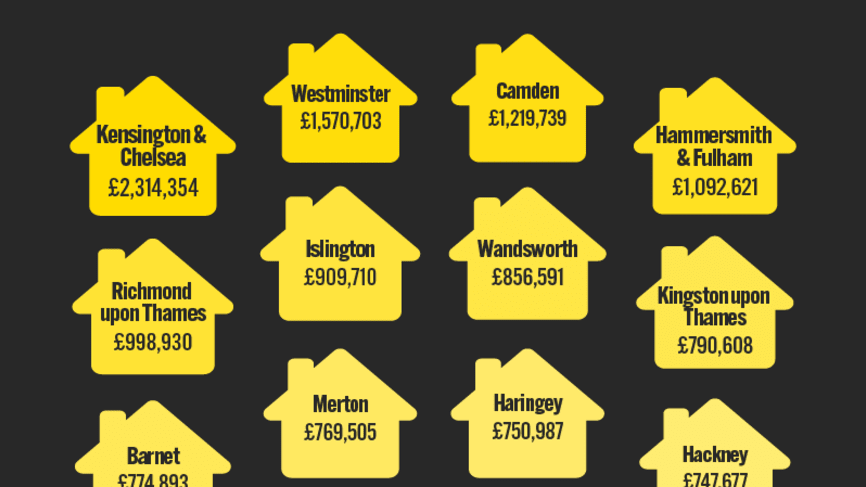
In order to determine which location had the best value-for-money house prices, we scoured Zoopla to find how many properties sold for on average in the last 12 months, including detached houses, semi-detached houses, terraced houses and flats.
In first place were Barking and Dagenham, with a maximum score of 10.0/10. The average house price in this borough was revealed to be £358,041, which is impressive given its proximity to the centre of London.
Bexley was in second place with a score of 9.7/10 - very close to stealing the top spot. This is due to the fact that houses in this borough cost, on average, around £439,467.
In third place was Newham, with another very impressive score of 9.4/10. We found that the average house price on Zoopla was £443,987 for this location, highlighting the great value for money that the average home in the top three boroughs provides.
In last place as the most expensive area to live, and slightly unsurprisingly, were Kensington and Chelsea. With the reality show ‘Made in Chelsea’ showcasing the opulence and wealth of the borough and the people residing in it, it wasn’t a shock to learn that the average house in this area costs £2,314,354. This scored the location a measly 0.0/10, with house prices that would well and truly break the bank for most.
The second most expensive houses were in the London borough of Westminster with a disappointingly low score of 0.3/10. Having Buckingham Palace on your doorstep doesn’t come cheap, with houses in the area costing a whopping £1,570,703.
Emerging as the third most expensive borough of London to lay down roots is Camden with an unappealing score of 0.6/10. The bustling area known for its popular Camden Market, boasting an extensive range of shops, stalls, bars and eateries comes with a hefty price tag for houses at £1,219,739.
Which London borough has the most and least noise complaints?
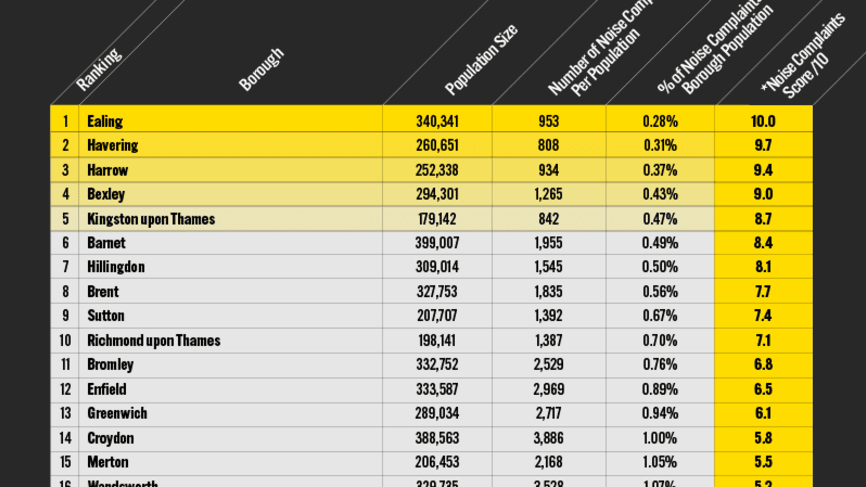
Finally, we looked into the boroughs that had the least amount of noise complaints - and the unlucky ones that had the most. In first place was the quiet, tranquil borough of Ealing, which was discovered to have 953 noise complaints per population size (340,341). This gave it an overall score of 10/10 with just 0.28% of complaints per borough population.
In second place was Havering, which achieved a ranking of 9.7/10. This exceptionally high score was due to 808 noise complaints per population size of 260,651 - which works out at 0.31%. Up in third was Harrow with 934 complaints, which works out at 0.37% of the population of 252,338. This scored the location an impressive 9.4/10 in total.
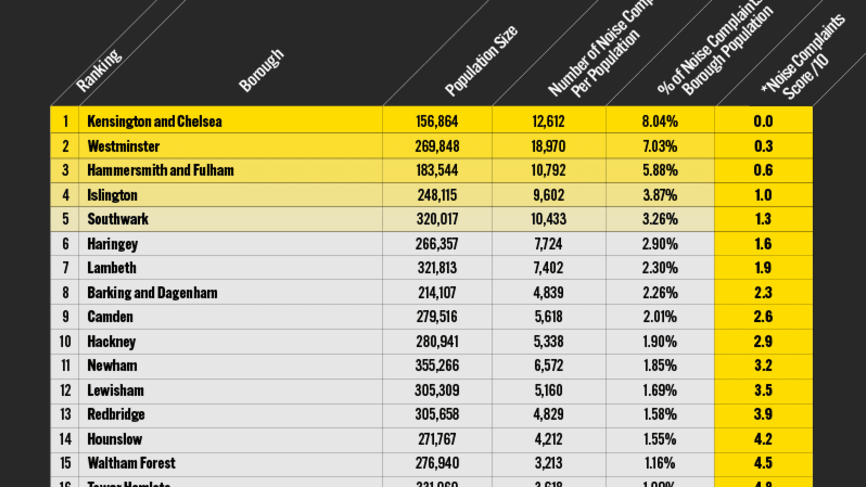
Kensington and Chelsea fell into last place once again, with a total score of 0.0/10. The population of 156,864 has 12,612 average noise complaints, which works out at a worrying 8.04% per population size - possibly due to raucous ‘Made in Chelsea’ parties.
Methodology:
Overall ranking - We identified which London Borough would be the best to live in by analysing eight factors. These factors were the number of publicly accessible parks, the percentage of accessible tube stations, the percentage of cheaper supermarkets, distance to the centre, cost of travel to the centre by public transport and bus only, average house prices and percentage of noise complaints per borough population.
The most green space - We analysed the amount of green space in hectares of each London borough's publicly accessible park. We then scored the boroughs out of 10 overall and ranked them.
Percentage of accessible tube stations - We found the number of tube stations in each borough, and calculated what percentage of these were accessible. We then scored the borough's percentages out of 10 and ranked them.
Cheaper Supermarket Stores - These were selected using a seed list (https://www.goodto.com/money/cheapest-supermarkets-657819) stating the top three cheapest supermarkets. We then used store locators to work out how many stores were in each borough, and calculated how many stores there were per square meter of each borough.
Travelling to the city centre - The distance was calculated using Google Maps’ ‘measure distance’ tool. For the cost prices to travel to the city centre, we used the TFL Journey Planner; we filtered the search results by choosing travel by Bus, National Rail, London Overground, Tube, DLR and the Elizabeth Line. We also made sure these searches were for journeys occurring on Wednesday 30th November 2022 at 10am, for all Boroughs.
Average House Prices - This is the average selling price of detached houses, semi-detached houses, terraced houses and flats within the London Boroughs in the past 12 months.
Percentage of noise complaints - We used the number of noise complaints per 1,000 population and calculated the percentage against the total Boroughs population.
Sources:
Good To Know | TFL | Asda | Aldi | Lidl | Wikipedia | Go Parks | Brent Youth Zone | Bromley Parks | Camden Gov | Feraa | Visit Greenwich | Hackney | Haringey | Harrow Gov | Hillingdon Gov | The Royal Borough of Kensington and Chelsea Gov | The Royal Borough of Kingston Upon Thames Gov | Lewisham Glendale Local | Merton Gov | Newham Gov | Redbridge Gov | Sutton Gov | Tower Hamlets | Waltham Forest Gov | Wandsworth Gov | Westminster Gov | Transport For All | All In London | Google Maps | Zoopla | LG Inform | Statista | London Gov | Wikipedia | My London




